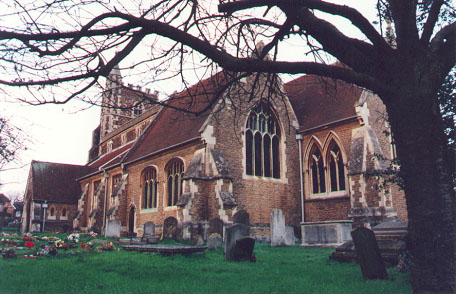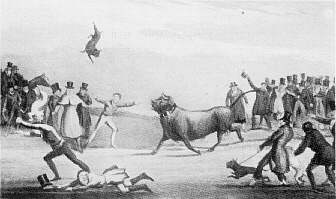|
The town of Wokingham, Berkshire, is situated some 50 kilometres west of the City of London in the gentle undulating countryside of eastern Berkshire. It is situated on a rise overlooking the surrounding countryside, and as a small market town was the centre of trade and exchange for the local area. As a manufacturing centre it was principally renowned for the production of silk, and, as recorded in a County Directory from the 1830's, "a considerable quantity of shoes".
The town is set out about three principal streets which meet at the spacious area of the market place. The town name Wokingham, meaning the "homestead of the people of Wocc or Woccings", has had many variations throughout the ages, most commonly Oakingham and Ockingham, meaning the "town of the forest", as in the 1700's it lay within a few miles of Windsor Forest. Emm Brook flows to the south and west of the town eventually joining with the River Loddon which flows into the Thames. A small part of Wokingham Parish is located in the Hundred of Amesbury, County Wiltshire, though most of it is situated in the Hundred of Sonning, Berkshire.

All Saints Parish Church, Wokingham.
Wokingham Parish Church, All Saints, was built at the end of the 1400's on the site of an earlier 12th century church, and over the centuries has undergone various repairs and modifications. Directories of the mid 1800's describe it thus :
"The Church, dedicated to All Saints, is an ancient fabric. It is a large and spacious structure, [with] a square tower and six bells, situated in that part of the parish which is in Wiltshire. The interior consists of a nave and aisles, separated by piers and fine lofty arches. It is lighted by clerestory windows, and contains a handsome organ....The roof is a rare specimen of carved oak....The inside of it's walls are principally chalk, the outside composed of rough grout work..."
The Pigot & Co. Directory of Berkshire from 1830 describes the County and Town thus :
"To the South [of the Thames] is the remarkably fertile vale of Berks, the prevailing soil of which is a strong grey calcareous loam...
Oakingham, or Wokingham, is a market-town, in a Parish of it's name, that is principally in the Hundred of Sonning, a small part of it in the Hundred of Amesbury, Wiltshire; and situated upon the edge of Windsor Forest; distant from London 31 miles and Reading seven. The town consists chiefly of three streets, which, meeting in an open centre, form a spacious area, wherein the market house and town hall are situated.
Under the heading of manufactures can only be noticed that of silk-throwing and the making of a considerable quantity of shoes; the trade is, however, of a nature chiefly confined to the town, and assisted by those employed in agriculture.
The country around here is very delightful, and the neighbourhood exceedingly genteel. The Market Day which is on Tuesday, is an excellent one for poultry : the fairs are, April 23d, June 11th, October 10th, and November 2d. The population of that part of the parish in the county of Berks, in 1821, was 2490, and in that part situated in Wiltshire 320; total number of inhabitants 2,810."
A later Post Office Directory from the 1840s reveals subsequent developments in Wokingham's history :
"There are several gentleman's residences in the neighbourhood; a principal one is Bear Wood Park, the seat of John Walter, Esq., who has recently erected on his estate a very handsome church, at his own expense.
The population, in 1841, was 3,319 and the area in acres 8, 456. About a mile from town, at Chapel Green, is a hospital founded by Henry Lucas, Esq., in 1685, for the maintenance of 12 poor men, who each receive £20 per annum, and a master, whose salary is £100 per annum...
The market is held on Tuesday for corn, and was formerly the first market in the county for poultry, but very small quantities are now brought for sale..."
Market day and town fairs in Wokingham were spirited occasions. Drinking, gambling, cock-fighting, and dog-fighting were common practice, and men fought for prizes of beer. The cock-pits also hosted the fighting of women, where two women, naked to the waist, would fight in the pits clutching a coin in each hand to prevent hair-pulling.
Wokingham was the county centre for the practice of bull-baiting. Bull-baiting was at one time law, deemed necessary for the production of tender meat. The killing of bulls without "baiting them according to custom" was against the law and punishable by fine, and many butchers were fined for this crime. On Market Day the bait attracted large crowds, blocking streets with carriages, with every nearby window, rooftop and vantage point crowded with people.

The baiting of a bull.
Bulls to be baited were tethered by a fifteen foot chain to a ring in the market place. Often bulls were infuriated by having their noses filled with pepper. A bulldog was set upon the bull, whose task it was to attach himself to the bull's nose while avoiding the horns which could toss him into the air or kill him outright. When the bull was considered suitably baited it was led away for slaughter, and another led out to be baited. Rival dog owners taunted and fought each other because of cowardly dogs, and on occasions a person was killed by a bull. Many notes in All Saints Burial register simply record "Killed by bull" along with the person's name and date of burial. The practice of bull-baiting was eventually prohibited in 1821.
In 1815 Tuesday was market day in Wokingham, while the town fairs occurred in late March, and on June 11, September 21, and November 2. The end of a market day was often just as eventful as the market itself. When the market day crowd eventually dispersed many stole and poached on their journey home.
The burial register of All Saint's parish church, Wokingham, records:
|
Elizabeth North |
was buried Decr 26th 1794. She was found dead,
dreadfully bruised, the morning after Bullbaiting; The Coroner with his Inquest found her "accidentally killed."
W. Bremner |
|
A Man Unknown, |
according to the Coroners inquest, who was found dead in a field in this parish with his throat cut, was buried December 10th 1806 / about... (torn page)
It was afterwards discovered that the name of the [deceased] (torn page) was Edward Brown, and that he had resided at Sherborne in Dorsetshire. |
But for all this the exchange of local produce was the mainstay of the Wokingham tradesmen and farmers.
Wokingham's farmers occupied their lands by one of three types of tenure. Freeholders held their land direct from the Crown and enjoyed absolute possession, in which they were protected by the law. Their holdings might be large or small, consolidated or in open fields. Copyholders held their land subject to the payment of quit-rent, the land usually situated in open fields. Quit-rent originated as a compensation payed to the Lord of the Manor for services no longer renderd by a servant wishing to leave the Lords employ and farm for himself on the Lords land. Over time this simply became a land rent that could not be varied, and the tennant could not be evicted so long as he continued to pay the rent. Leaseholders held their land for a term of years from a Freeholder and paid a competitive rent for their property. Their farms were as a rule consolidated.
The term "yeomen" was generally applied to small freeholders, although there are examples to the contrary indicating that copyholders and leaseholders were sometimes also referred to as "yoemen". It appears that the term was sometimes used to describe the social and economic position of the men in question rather than the tenure by which they held their land. The yeoman farmer was regarded above the general labourer but below the landed gentry.
In the early 1800's life on the land changed for ever. Enclosure of the open field Manors and of the Common lands was enforced by an Act of Pariliament. A general Enclosure Act was passed in 1801, but it was still neccessary to obtain parliamentary authority for each case of enclosure. Enclosure occurred in Wokingham in 1817, and without the right to Common ground to graze their animals many farmers were forced from the land. The yeomen farmers who disappeared at the time of the enclosure acts generally had small holdings in the open fields enclosed and adjacent to the Commons. This was certainly true of the Hales of Wokingham, who ceased to be landowners around this time.
© The above text and compilation of information Copyright David Hale and Joan Hale 1999.
|

